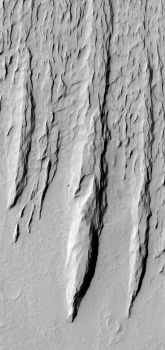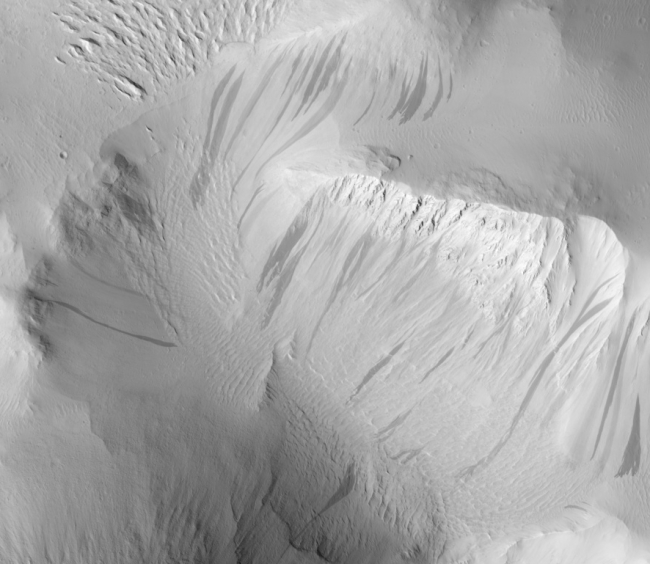The wild Martian terrain

This week’s image release from the high resolution camera on Mars Reconnaissance Orbiter illustrate well the wild and mysterious geology of the Martian surface. I include cropped sections from two images here, just to give you a taste. Go to the link to do your own exploring.
The image to the right is a cropped and scaled down version of the original image, so the details are not easily seen. Make sure you look at the original. The strange yardang ridges, all aligned alike, rise up out of a relatively smooth plain.
Yardangs are formed when a surface that is composed of materials of differing strengths (i.e., of both harder and softer materials) is shaped by the abrasive action of sand and dust carried by the wind. In this case, and given the proximity of the Apollonaris Patera volcanic center, we think that these wind-carved deposits are comprised of volcanic ash and pyroclastics that erupted from Apollonaris when it was last active in the not-too-distant geologic past. Over time, the softer materials (likely volcanic ash) were eroded away, leaving behind the harder materials in the form of elongated ridges that are parallel to the direction of the prevailing wind. The end result is a stunning, out-of-this-world display of yardangs, sculpted with the artistic chisel of the Martian wind.
That’s the theory, anyway. The actual geological process that formed these ridges is probably a lot more complicated.
The image below the fold illustrates the on-going surface activity on Mars.

The image comes from a region just northwest of Mars’ largest volcano, Olympus Mons. Here, landslides of the thick Martian dust that covers the planet’s surface cause the dark streaks, which with time lighten as new dust is deposited on top. Meanwhile, the dust accumulates in the depressions at the base of these slopes, forming wind-formed sand dunes, almost like frozen waves on a pond. Only here, the pond is made of dust.
These two images are only a sample, and a cropped one at that. Make sure you look at the originals. You will find the barren complexity of the Martian terrain somewhat daunting. It will take generations of geologists many decades to figure it all out. And those geologists will have to do it on the Martian surface. Trying to gain a good understanding of this geology remotely from Earth will likely never be possible.
On Christmas Eve 1968 three Americans became the first humans to visit another world. What they did to celebrate was unexpected and profound, and will be remembered throughout all human history. Genesis: the Story of Apollo 8, Robert Zimmerman's classic history of humanity's first journey to another world, tells that story, and it is now available as both an ebook and an audiobook, both with a foreword by Valerie Anders and a new introduction by Robert Zimmerman.
The ebook is available everywhere for $5.99 (before discount) at amazon, or direct from my ebook publisher, ebookit. If you buy it from ebookit you don't support the big tech companies and the author gets a bigger cut much sooner.
The audiobook is also available at all these vendors, and is also free with a 30-day trial membership to Audible.
"Not simply about one mission, [Genesis] is also the history of America's quest for the moon... Zimmerman has done a masterful job of tying disparate events together into a solid account of one of America's greatest human triumphs."--San Antonio Express-News


Readers: the rules for commenting!
No registration is required. I welcome all opinions, even those that strongly criticize my commentary.
However, name-calling and obscenities will not be tolerated. First time offenders who are new to the site will be warned. Second time offenders or first time offenders who have been here awhile will be suspended for a week. After that, I will ban you. Period.
Note also that first time commenters as well as any comment with more than one link will be placed in moderation for my approval. Be patient, I will get to it.